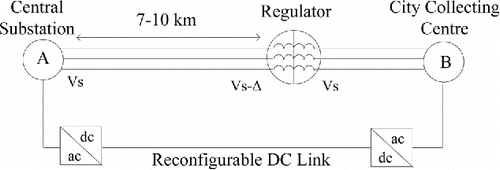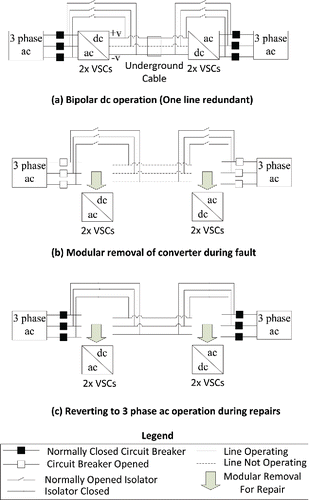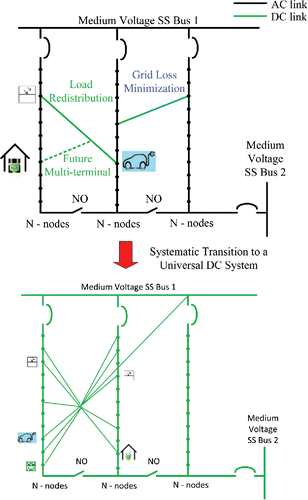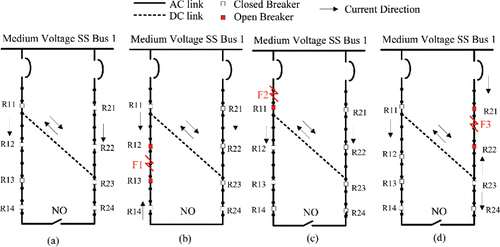Abstract
While the scientific community recognizes the benefits of DC power transfer, the distribution network operators point out the practical and economic constraints in refurbishing the existing AC network at a medium-voltage level. Some apprehensions like reliability, cost of ownership, and safety in adopting a universal DC distribution may merit considerable attention, particularly considering the long operational experience with the existing mature AC system. This paper introduces the novel concept of reconfigurable DC links as a flexible backbone integrated within the future AC distribution grids. Benefits such as hardware reconfiguration for a modular AC–DC cable operation to achieve fault redundancy, control reconfiguration for flexibility and grid-supporting ancillary services, network reconfiguration for system level distribution loss minimization and load redistribution, and fault reconfiguration for improving the grid availability are discussed. The vision, around which the concepts developed in this paper revolve around, is to present a viable way of gradual transition from AC to hybrid AC–DC to finally a universal DC system.
1. Introduction
Increasing integration of dispersed renewable energy sources in existing electricity supply systems has enabled bidirectional power flows in the AC distribution networks. New energy consumers like electric vehicles, all electric houses, and heat pumps have changed the localized energy consumption patterns and increased the expected demand from grid infrastructure several folds Citation[1, 2]. Infrastructural complexity and investment costs are required for maintaining sufficient and optimized power flows to cope with localized demand deficits and quality of supply at acceptable voltage deviations. The distribution network operators should have adequate flexibility and control on the grid operation. Reconfigurable DC links incorporated in the existing AC distribution grids can provide solutions to the challenges highlighted in the subsequent section. DC links can provide all the advantages of DC transmission systems Citation[3] like lower losses at critical highly loaded points, higher transmission capacity, bidirectional power control, and grid interconnectivity with distributed energy sources and storage, while offering a flexibility of reverting to the AC operation during contingencies such as converter faults. Furthermore, control functionalities programmed into the link converters can offer more flexibility and redundancies during an integrated grid operation. In , the challenges faced by AC network utility operators are listed and the corresponding opportunities with DC-based technologies are highlighted.
TABLE 1. Challenges in existing AC grids and opportunities for DC-based system.
The subsequent section elaborates on these challenges and opportunities. Then, the new concepts developed in this paper are presented and their potential is identified by reviewing the existing conventional practices. Finally, the limitations of the DC link technology and the means of mitigating them are discussed.
2. Challenges and Opportunities
2.1. Increase in Power Demand
A shift toward electric energy from traditional fossil fuel use in vehicles and heat pumps may trigger the need to enhance the capacity of existing distribution grids Citation[4].
| • | Electric vehicles (EVs) have high charging power demand. User behaviour of charging the EVs at certain scheduled time of the day could create local overload on the grid even though the installed capacity is enough for average loading conditions Citation[25]. | ||||
| • | Interest in adopting all-electric houses has increased the reliance on electrical energy Citation[26]. Some DNOs expect a significant hike in demand on their grid infrastructure if electrical heat pumps are used instead of conventionally used gas pipes. | ||||
FIGURE 1. Capacity enhancement with 3 × monopolar DC links from a three-phase AC link operating at a unity power factor.
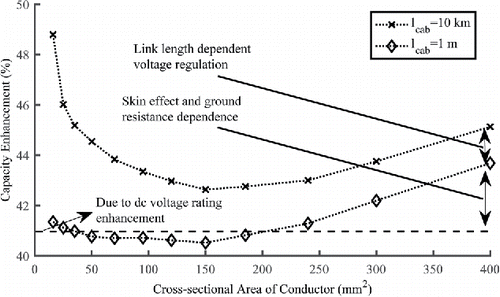
At a medium-voltage level of 10–66 kV, the transmission lines which bring the bulk power into the city collecting center from the central substation as shown in are at maximum loading conditions. The downline changes in loading pattern seldom take into account the consequences on this critical link. The reactionary responsibility of infrastructure overhauling falls on the DNOs. In case of overhead lines, modification to dc transmission can have considerable increase in power transmission capacity Citation[27] Similarly, with use of dc links, the power transfer capacity of existing underground cable infrastructure can be significantly enhanced Citation[4] as shown in . A detailed quantification of capacity enhancement under different scenarios is offered in Citation[28].
Interaction with utility operators indicates that most of the transmission losses in the distribution grid occur in these first few kilometers of the distribution grids. Therefore, employing DC links at these locations can also be beneficial in terms of efficiency enhancement. However, these are critical points of the distribution grids where a fault can cause outage of the entire city. Therefore, redundancy offered by the reconfigurability of the DC link can be advantageous.
3. Integrating Green Energy Resources
At a low-voltage distribution level, emerging grid components will need to be integrated into an AC or DC interconnection while carrying out the designated role in energy generation, storage, consumption, and protection. The power electronic interface of winds turbines, fuel cells, and PV modules with an existing AC microgrid is discussed in Citation[5]. In Citation[6], a comparative analysis on the component integration with AC and DC microgrids is performed. It is recognized that these components are inherently DC, or require an intermediate AC–DC–AC conversion stage. A DC interconnection can lead to the reduction in a conversion stage, thereby improving the efficiency. The creation of flexible DC nano-grids controlled independently in a distributed way and interconnected via a DC grid in an open energy system may lead to de-congestion and solve problems of intermittent nature of generation locally Citation[7, 10].
3.1. Meshing and Redundancies
The ability to revert to AC when the DC link operation fails during contingency is an important requirement, particularly at critical locations of bulk power transfer. Therefore, the architecture proposed is hardware-reconfigurable with the possibility of operating in both AC and DC.
An advantage of interconnecting different grid locations, thereby creating active closed loop grid architectures, is anticipated to fundamentally change how the future power grids will be designed and operated. The concepts such as network and fault reconfiguration of existing AC networks using optimally placed DC links are a pioneering focus of this paper.
3.2. Operational Flexibility
Big data applications in power utilities appear to be the next logical step toward smarter grids Citation[9]. Unlike Internet, the “Internet of things” envisioned in Citation[10] can reach its full potential only with greater hardware interconnectivity. We argue that reconfigurable DC links will invariably lead to greater grid interconnectivity. As the data volume increases, the attention will shift from information architecture and management toward decisions of optimal operation. Anticipating this, the control reconfigurability using flexible DC link backbones may be the natural and necessary evolutionary paths for the future power system architecture at its physical layer.
4. Novel Concept of Reconfigurable DC Links
This paper proposes novel concepts of employing reconfigurable DC links in existing AC distribution grids. Toward the vision of gradually transitioning from existing AC to a universal DC distribution, the following ideas are developed:
| • | Hardware reconfigurability for modular AC–DC cable operation to achieve fault redundancy at critical grid locations. | ||||
| • | Control reconfigurability for greater flexibility and grid-supporting ancillary services. | ||||
| • | Network reconfigurability for loss minimization and feeder load redistribution using DC links. | ||||
| • | Fault reconfigurability for achieving higher availability. | ||||
This section explores the potential of these ideas further and supports their viability by highlighting the current and anticipated limitations of conventional AC utility grid architecture, control, and practices.
4.1. Hardware Reconfigurability
depicts one of the hardware system reconfigurations that can work as a bipolar DC link as well as revert to a three-phase AC operation during converter faults by a modular repair scheme. In this scheme, the three core cables operate as a bipolar DC link under normal operational conditions. Two of the cables can be fully loaded, while one is either redundant or acts as a return path as shown in . During converter faults, which are the least reliable part of the system, the circuit breakers on the AC side open and the faulted components can be modularly removed as shown in . The system can revert back to a three-phase three-line AC operation as shown in by closing the isolator and reclosing the circuit breakers at both sides.
In this way, we not only achieve a flexible and modular AC–DC operation by reusing the same underground cable infrastructure, but also save costs by common use of the circuit breakers for both operating modes. The isolators are cheaper and used only for AC connection, and remain normally open during the DC operation. These isolators are not operated to make or break cable current, which is done using the commonly connected circuit breakers. The consequences of refurbishing the underground AC cable to operate under DC conditions are discussed in Citation[4].
4.2. Network Reconfiguration
The idea of reconfiguring the conventional AC network by redirecting power from one feeder to another to achieve system level loss minimization and load balancing is proposed in Citation[11, 12]. Recently, a similar study presents the benefits for variable load demand Citation[13]. However, in such an AC network restructuring concept, the constraint of maintaining the radial structure must be kept, due to the synchronization requirements.
The advantages of a radial distribution network and the possibility of loss minimization and service restoration using reconfiguration have led to the design of weakly meshed grids which are then operated in a radial mode and restructured using switching operations through efficient optimization techniques Citation[14]. While such techniques of branch exchanges for the network reconfiguration have been explored extensively in the literature, the radial constraint is respected in all such studies Citation[11–16].
Interestingly, it was noted as an afterthought in Citation[16] that if a network configuration with a limited number of loops could be allowed, substantial reduction of resistive line losses over those of the optimum radial configuration may also be achieved. Considering that at the distribution level, a looped operation was unfavorable for AC, this was never explored further.
Considering that the point-to-point DC links can asynchronously interconnect two AC grid locations, it can be easily appreciated that the benefits of “radial” AC operation and network reconfiguration for loss minimization, load balancing, service restoration, and reactive power support using a flexible DC link backbone can be combined Citation[24]. The An optimal placement of dc links in existing ac distribution networks can be beneficial, as illustrated in .
Trade-offs in terms of cost of front and back convertors for DC links and their operating losses are added constraints, while new benefits such as rapid response, better control, efficient cable operation, enhancement in power transfer capability, and flexibility with ancillary services like harmonic elimination, power redirection, and voltage support should be incorporated in future problem formulations in this field.
The most interesting potential of this concept is the scalability of a multi-terminal DC skeleton within the existing AC grid, integrating distributed generation resources and energy-intensive consumers to achieve a “Grid within a grid,” therefore, paving way for the vision of realistically transitioning toward a universal DC distribution in a systematic way, as illustrated in .
4.3. Fault Reconfigurability
The hybrid AC/DC medium-voltage system has great advantages over conventional AC distribution systems. In the conventional AC system, the tie switches are usually used to achieve service restoration once the fault occurs. This existing fault mitigation strategy has some disadvantages. First, after the fault is isolated, the downstream loads would be interrupted before they are reenergized by another feeder. Second, the new network topology caused by the closing of tie switch will cause high system losses and poor voltage profiles along the feeder since the closing of tie switch makes the main feeder much longer. The healthy radial AC system with a single point-to-point reconfigurable DC link is shown in .
In case (b), when fault F1 occurs between R12 and R13, that section is isolated and the nodes from R13 and end point are fed by closing the NO tie-line. The DC link converters generally have a fault ride through capability and can remain in operation. In this case, there is not much difference as compared to the system without the DC link, apart from the fact that the performance can be better due to inherent tolerance to over-currents and the capability to support the node voltage.
In case (c), when fault F2 occurs near the main bus, the DC link can provide supply to a downstream node and it is not necessary to switch in the tie-line. Apart from reducing the number of switching operations, this scenario also results in a better voltage profile and lower losses. It also does not result in a change in the current direction, which is an issue with an over-current relay coordination discussed in Citation[15].
Similarly, in case (d), fault F3 can be isolated without interrupting the supply to other loads and avoiding the need to operate the tie-line. Therefore, it can be concluded that any fault between the main bus and the DC link end will reduce the tie-line operation and the losses, while improving the overall voltage profile. For faults between the DC link end and the tie-line, the fault ride through can guarantee a similar better performance than the original system.
It is also important to consider the constraints' relay coordination (R11–R14 and R21–R24) which is applied to the network reconfigurability. In the conventional radial system reconfiguration by branch exchange, this coordination necessitates the avoidance of some branch operations Citation[15]. In approaching the optimization problem with DC link placement, this constraint is also not relevant, thereby allowing more choices.
4.4. Control Reconfigurability
| • | DC links can be reconfigured to provide interconnectivity between one phase of the grid to another phase of the grid geographically located away from each other as shown in . In case there is excess generation due to distributed sources in phase a1 in one part of the grid and local power deficit due to high demand in phase c2 in another part, the power can be redirected easily, efficiently, and rapidly by reconfiguring the converters without synchronization issues. This redirection may be beneficial in low-voltage microgrids with local pockets of power surplus and deficits. An adequate control algorithm for the DC links can offer flexibility in the operation of the distribution grid. | ||||
| • | If a bipolar configuration is employed, the system can be reconfigured to operate in a monopolar mode for limited time Citation[1] with 50% capacity during single-line faults. | ||||
| • | Flexible operation of link converters as STATCOM for reactive power injection and harmonic elimination when the link is operating under AC conditions. | ||||
5. Limitations in Employing Reconfigurable DC Link Technology
Given the less mature market for DC technologies, particularly in terms of DC breakers Citation[17] and minimal penetration of DC transmission in MV/LV distribution grids, point-to-point connections as a flexible backbone to the AC network are preferable as the starting point. To have more meshed interconnection and renewable energy integration toward the transition to DC grids, the following limitations must be addressed:
| • | High infrastructure costs associated with the link converter will always need to be balanced against savings due to capacity and efficiency enhancement, and the flexibility offered by the DC operation. | ||||
| • | Protection continues to remain a bottleneck. The DC link suffers from high short circuit currents due to the absence of inductive drop. In general, there is a trade-off between stability and short circuit current limit with respect to the capacitance of the DC link. | ||||
| • | Power electronic converters installed near residential areas can be a source of noise. Multi-level converter operating with frequencies beyond 20 kHz can be used for noiseless operations. | ||||
| • | Converters are the least reliable components in the proposed system. Outage due to fault can increase the grid downtime. With the use of modular converters, this downtime can be reduced. Furthermore, redundancies due to reconfigurability of the DC link, as suggested in this paper, will improve reliability and ensure uninterrupted operations during contingencies. | ||||
Protection
A reliable and coordinated protection strategy is perhaps the greatest hindrance toward a truly interconnected meshed DC network Citation[6]. DC links can prevent AC faults from affecting other parts of the AC grid. However, the use of switches, which are prone to failure, and the nature of the DC current itself make protection one of the biggest challenges in DC links. So far, DC point-to-point connections have only been protected via the use of AC breakers. This is also the reason why we limit ourselves in highlighting the potential of point-to-point reconfigurable DC links. In the case of Line-Commutated current-sourced convertors technology, the thyristor valves can block their operation and thus prevent the AC side from feeding the DC fault. However, this is not possible in the case of voltage-sourced convertors. As soon as a fault occurs, the control is blocked and the converter operates as a diode bridge continuously feeding the fault until a means of isolation is activated. Unless a DC grid is in place, no fast DC fault isolation is required, as the faulty DC line can no longer assist the normal power flow and it will need to be shut down for maintenance Citation[18].
The problem of protection becomes more prominent in the case of meshed DC grids. In this case, the faulty line needs to be isolated fast enough to prevent the fault from affecting the operation of the “healthy” part of the grid. As soon as a DC fault occurs, there are three distinct stages of grid reaction. First, the DC fault needs to be detected. Second, the grid assets need to be protected and the fault needs to be isolated before the fault currents reach a critical level. Finally, the operation should be restored as soon as possible in the grid part that is not affected by the fault, minimizing the overall economic losses Citation[19].
Previous research has been conducted on the DC fault currents developing stages, as well as on DC fault selective detection and localization methods Citation[18]. These studies showed that the DC fault dynamics are very fast (2–5 msec) and thus, the time restrictions imposed are very stringent. Moreover, several studies have investigated the design of DC circuit breakers Citation[20, 21], while other protection concepts along with fault blocking converter designs have been proposed Citation[22, 23]. However, the proposed solutions have many design trade-offs and thus require a high level of optimization to define the best possible design of a protection system in DC grids.
6. Conclusion
Installing reconfigurable DC links in existing AC distribution networks can offer modularity and redundancy, flexibility of operation, and optimized power flow with loss minimization, as well as better availability and performance during faults. The novel ideas presented in this paper open an entirely new research direction in designing future hybrid power systems with a more involved AC and DC integration.
Hardware reconfigurability to achieve a modular AC–DC link operation not only allows grid operators to test the operational benefits of DC power transfer, but also gives them the option to revert to AC operation during contingencies like link converter fault, which are the least reliable part of the proposed system. Common use of circuit breakers and cables during AC and DC operations offers savings in infrastructure costs incurred.
Network reconfigurability with DC link breaks a limiting radial constraint that the AC distribution system imposed in the load balancing and loss minimization problems. The proposed concept is scalable to multi-terminal DC systems. An efficient interconnection of DC-distributed generation sources like PV and energy-intensive consumers like EVs makes it possible to integrate a DC “nano-grid within the grid.”
In fault reconfiguration requirements, it is argued that the proposed architecture would be better with minimum operation of tie-line, better voltage profile, and lower losses. The constraints put by a protection relay coordination in restructuring the network for feeder redistribution are also alleviated.
The vision of this paper of creating a platform for systematic transition from an all-AC distribution network toward a universal DC system is developed.
Acknowledgments
This work is funded by tki switch2smartgrids under the project Flexible and Future Power Links for Smart Grids (FLINK). We thank all the project partners for their involvement. We would like to thank the distribution network operators from Dutch utility companies like Alliander, Enexis and Stedin for helping us understand the challenges in designing the evolving grids of the future.
Additional information
Funding
Notes on contributors
Aditya Shekhar
Aditya Shekhar is currently pursuing his Ph.D. in Delft University of Technology. He was a guest researcher in The University of Texas at Austin in the fall of 2016. He completed his M.Sc. in electrical sustainable energy in 2015 with cum laude from the Delft University of Technology. He was awarded the IDEA League Scholarship to work on his M.Sc. thesis in ETH, Zurich, in the High Voltage Laboratory. He was also given an honors degree for his internship work in TNO, the Netherlands, in the field of solar roads and wireless energy transfer. He finished his bachelor's degree in electrical with distinction in 2010 from National Institute of Technology, Surat, India, and gained experience as a field engineer in Uniphos Ltd. Later, he worked as a researcher in IIT, Bombay, India, for exploring energy conservation, benchmarks, and renewable energy transition studies for railways. His research interests include various topics of electric power engineering.
Laura Ramírez-Elizondo
Laura Ramírez-Elizondo is assistant professor at the DC Systems, Energy Conversion & Storage group. In 2003, she received her bachelors degree in Electrical Engineering and her bachelors degree in Music with a major in Piano at the Universidad de Costa Rica. She graduated with honors from her M.Sc. studies in Electrical Power Engineering at Delft University of Technology in 2007. She holds a PhD in electrical engineering from the Delft University of Technology (2013). Her research interests include various topics of electric power engineering.
Xianyong Feng
Xianyong Feng received his Ph.D. degree in the Department of Electrical and Computer Engineering at Texas A&M University, College Station, TX, USA, in May 2012. He is currently with Center for Electromechanics, The University of Texas at Austin. Prior to that, Dr. Feng worked with ABB, Raleigh, NC, USA, and ExxonMobil, Houston, TX, USA. His research interests are in the areas of microgrids, shipboard power systems, and DC power system protection.
Epaminondas Kontos
Epameinondas Kontos was born in Greece in 1988. He received the M.Sc. (Hons.) degree in sustainable energy technology from the Delft University of Technology (TU Delft), Delft, the Netherlands, in 2013. Since 2013, he has been a Ph.D. Researcher with the TKI Synergies at Sea Project at the DC&S Group of TU Delft. His research interests include various topics of electric power engineering.
Pavol Bauer
Pavol Bauer is currently a full Professor with the Department of Electrical Sustainable Energy of Delft University of Technology and head of DC Systems, Energy Conversion and Storage group. He published over 80 journals and almost 300 conference papers in his field, he is an author or co-author of 8 books, holds 5 international patents and organized several tutorials at the international conferences. He has worked on many projects for industry concerning wind, solar and wave energy, power electronic applications for power systems such as Smarttrafo; HVDC systems, DC distribution grids and microgrids, projects for smart cities such as PV charging of electric vehicles, PV and storage integration, contactless charging; and he participated in several Leonardo da Vinci and H2020 EU projects as project partner (ELINA, INETELE, E-Pragmatic) and coordinator (PEMCWebLab.com-Edipe, SustEner, Eranet DCMICRO). His research interests include various topics of electric power engineering.
References
- Chandra Mouli, G. R., Bauer, P., and Zeman, M., “System design for a solar powered electric vehicle charging station for workplaces,” Appl. Energy., Vol 168, 15 April 2016.
- Gustafsson, M., Gustafsson, M. S., Myhren, J. A., Bales, C., and Holmberg, S., “Techno-economic analysis of energy renovation measures for a district heated multi-family house,” Appl. Energy, Vol. 177, 2016.
- Justo, J. J., Mwasilu, F., Lee, J., and Jung, J., “AC-microgrids versus DC-microgrids with distributed energy resources: A review,” Renew. Sust Energy Rev., 2013.
- Shekhar, A., Kontos, E., Rodrigo Mor, A., Ramírez-Elizondo, L., and Bauer, P., “Refurbishing existing MVAC distribution cables to operate under DC conditions,” Power Electronics and Motion Control Conference and Exposition, 17th International, Varna, 2016.
- Blaabjerg, F., Chen, Z., and Kjaer, S. B., “Power electronics as efficient interface in dispersed power generation systems,” IEEE Trans. Power Electron., Vol. 19, No. 5, pp. 1184–1194, September 2004.
- Planas, E., Andreu, J., Gárate, J. I., de Alegría, I. M., and Ibarra, E., “AC and DC technology in microgrids: A review,” Renew. Sust Energy Rev., Vol. 43, March 2015.
- Olivares, D. E., Mehrizi-Sani, A., Etemadi, A. H., Canizares, C. A., Iravani, R., Kazerani, M., Hajimiragha, A. H., Gomis-Bellmunt, O., Saeedifard, M., Palma-Behnke, R., Jimenez-Estevez, G. A., and Hatziargyriou, N. D., “Trends in microgrid control,” Smart Grid IEEE Trans., Vol. 5, No. 4, pp. 1905–1919, July 2014.
- Werth, A., Kitamura, N., and Tanaka, K., “Conceptual Study for open energy systems: Distributed energy network using interconnected DC nanogrids,” Smart Grid IEEE Trans., Vol. 6, No. 4, pp. 1621–1630, July 2015.
- Lai, C. S., and McCulloch, M. D., “Big data analytics for smart grid,” (2015) Retrieved from http://smartgrid.ieee.org/newsletters/october-2015/big-data-analytics-for-smart-grid. Accessed 01.02.17.
- Hashem, I. A. T., Chang, V., Anuar, N. B., Adewole, K., Yaqoob, I., Gani, A., Ahmed, E., and Chiroma, H., “The role of big data in smart city,” Int. J. Inform. Manage., Vol. 36, No. 5, October 2016.
- Baran, M. E., and Wu, F. F., “Network reconfiguration in distribution systems for loss reduction and load balancing,” IEEE Trans. Power Deliv., Vol. 4, No. 2, pp. 1401–1407, April 1989.
- Baran, M. E., and Wu, F. F., “Optimal capacitor placement on radial distribution systems,” IEEE Trans. Power Deliv, Vol. 4, No. 1, pp. 725–734, January 1989.
- Zidan, A., and El-Saadany, E. F., “Impacts of feeder reconfiguration on renewable resources allocation in balanced and unbalanced distribution systems,” 2012 IEEE Power and Energy Society General Meeting, San Diego, CA, 2012, pp. 1–8.
- Jiang, D., and Baldick, R., “Optimal electric distribution system switch reconfiguration and capacitor control,” IEEE Trans. Power Syst., Vol. 11, No. 2, pp. 890–897, May 1996.
- Bhattacharya, S. K., and Goswami, S. K., “Distribution network reconfiguration considering protection coordination constraints,” J. Electr. Power Comp. Syst., Taylor and Francis, Vol. 44, pp. 974–989, May 2016.
- Shirmohammadi, D., and Hong, H. W., “Reconfiguration of electric distribution networks for resistive line losses reduction,” IEEE Trans. Power Deliv., Vol. 4, No. 2, pp. 1492–1498, April 1989.
- Jovcic, D., Van Hertem, D., Linden, K., Taisne, J.-P., and Grieshaber, W., “Feasibility of DC transmission networks,” Innovative Smart Grid Technologies (ISGT Europe), 2011 2 nd IEEE PES International Conference and Exhibition, pp. 1–8, 5–7 December 2011.
- Kontos, E., Pinto, R. T., Rodrigues, S., and Bauer, P., “Impact of HVDC transmission system topology on multiterminal DC network faults,” Power Deliv. IEEE Trans., Vol. 30, No. 2, pp. 844–852, April 2015.
- Kontos, E., Pinto, R. T., and Bauer, P., “Providing dc fault ride-through capability to H-bridge MMC-based HVDC networks,” Power Electronics and ECCE Asia (ICPE-ECCE Asia), 2015 9th International Conference, pp. 1542–1551, 1–5 June 2015.
- Mokhberdoran, A., Carvalho, A., Leite, H., and Silva, N., “A review on HVDC circuit breakers,” Renewable Power Generation Conference (RPG 2014, 3rd), pp. 1–6, September 2014.
- Bucher, M. K., and Franck, C. M., “Fault current interruption in multiterminal HVDC networks,” Power Deliv. IEEE Trans., Vol. 31, No. 1, pp. 87–95, February 2016.
- Adam, G. P., Abdelsalam, I. A., Ahmed, K. H., and Williams, B. W., “Hybrid multilevel converter with cascaded H-bridge cells for HVDC applications: Operating principle and scalability,” Power Electron. IEEE Trans., Vol. 30, No. 1, pp. 65–77, January 2015.
- Merlin, M. M. C., Green, T. C., Mitcheson, P. D., Trainer, D. R., Critchley, R., Crookes, W., and Hassan, F., “The alternate arm converter: A new hybrid multilevel converter with DC-fault blocking capability,” Power Deliv. IEEE Trans., Vol. 29, No. 1, pp. 310–317, February 2014.
- Teixeira Pinto, R., Aragüés-Peñalba, M., Gomis-Bellmunt, O., and Sumper, A., “Optimal Operation of DC Networks to Support Power System Outage Management,” IEEE Trans on Smart Grid., Vol. 7, no. 6, pp. 2953–2961, Nov. 2016. doi: 10.1109/TSG.2016.2586024
- Mallig, N., Michael Heilig, M., Weiss, C., Chlond, B., and Vortisch, P., “Modelling the Weekly Electricity Demand Caused by Electric Cars,” Procedia Computer Science., Vol. 52, pp. 444–451, 2015, ISSN 1877-0509, https://doi.org/10.1016/j.procs.2015.05.012.
- Jones, R. V., and Lomas, K. J., “Determinants of high electrical energy demand in UK homes: Appliance ownership and use,” Energy and Buildings., Vol. 117, pp. 71–82, 2016, ISSN 0378-7788, https://doi.org/10.1016/j.enbuild.2016.02.020.
- Clerici, A., Paris, L., and Danfors, P., “Hvdc conversion of hvac lines to provide substantial power upgrading,” IEEE Trans on Power Delivery, Vol. 6, no. 1, pp. 324–333, 1999. doi:10.1109/61.103755.
- Shekhar, A., Kontos, E., Ramírez-Elizondo, L., Mor, A. R., and Bauer, P., “Grid Capacity and Efficiency Enhancement by Operating Medium Voltage AC Cables as DC Links with Modular Multilevel Converters,” J. Electr. Power Energy Syst., Elsevier, 2017.

